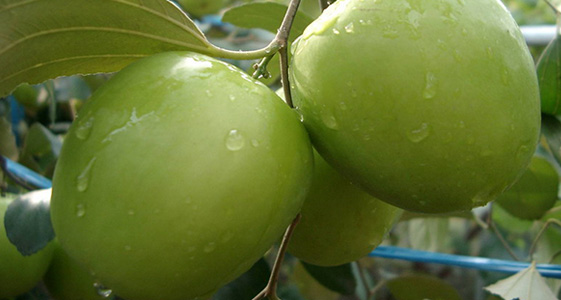
 Ber is the Urdu name for the fruit of the tree Zizyphus vulgaris,
or mauritania or sativa and is called the jujube berry in English.
It is also known as the Indian jujube or Chinese date. It has a brownish skin
when ripe and smells a little like hops, with an astringent taste.
These trees are believed to be native to Syria, but there is some evidence that
they are also native to the Indian subcontinent.
In Pakistan the fruit can be found in the month of December,
and it is sold then fresh, but can also be dried.
In Europe the fruit was made into a cough medicine and tisane for medicinal reasons in times past.
Ber is the Urdu name for the fruit of the tree Zizyphus vulgaris,
or mauritania or sativa and is called the jujube berry in English.
It is also known as the Indian jujube or Chinese date. It has a brownish skin
when ripe and smells a little like hops, with an astringent taste.
These trees are believed to be native to Syria, but there is some evidence that
they are also native to the Indian subcontinent.
In Pakistan the fruit can be found in the month of December,
and it is sold then fresh, but can also be dried.
In Europe the fruit was made into a cough medicine and tisane for medicinal reasons in times past.
It is a small deciduous tree or shrub reaching a height of 5–12 metres (16–39 ft), usually with thorny branches. The leaves are shiny-green, ovate-acute, 2–7 centimetres (0.79–2.76 in) wide and 1–3 centimetres (0.39–1.18 in) broad, with three conspicuous veins at the base, and a finely toothed margin. The flowers are small, 5 millimetres (0.20 in) wide, with five inconspicuous yellowish-green petals. The fruit is an edible oval drupe 1.5–3 centimetres (0.59–1.18 in) deep; when immature it is smooth-green, with the consistency and taste of an apple, maturing brown to purplish-black and eventually wrinkled, looking like a small date. There is a single hard stone similar to an olive stone.
Although the nutritional value of majority of the forest foods is not precisely known, but most of them which have been researched have been found to be a storehouse of nourishment.
There are various obvious reasons for the under consumption of underutilized fruits. -
Most indigenous fruit trees are not commonly cultivated on the farm and there is scant and dispersed knowledge about their fruits and their nutritive value.
People prefer to have fruits with good taste since wild fruits have high levels of the unpleasant tasting tannins and glycosides.
Indigenous fruits are neither large nor fleshy and contain lots of seeds.
The fruits are highly perishable and difficult to store in the fresh form.
Most wild fruits are not really easy and handy to eat.
Some fruit species are not acceptable as fresh fruit because of high acidity and/or strong astringent taste.
Most of them are often available only in the local markets and are rarely known in other parts of the country.
On the contrary, benefits of such underutilized fruits far exceed their limitations.
Laddu, Umran, Katha Rajasthan, Sua and Dandan
In India, some types ripen as early as October, others from mid-February to mid-March, others in March, or mid-March, to the end of April